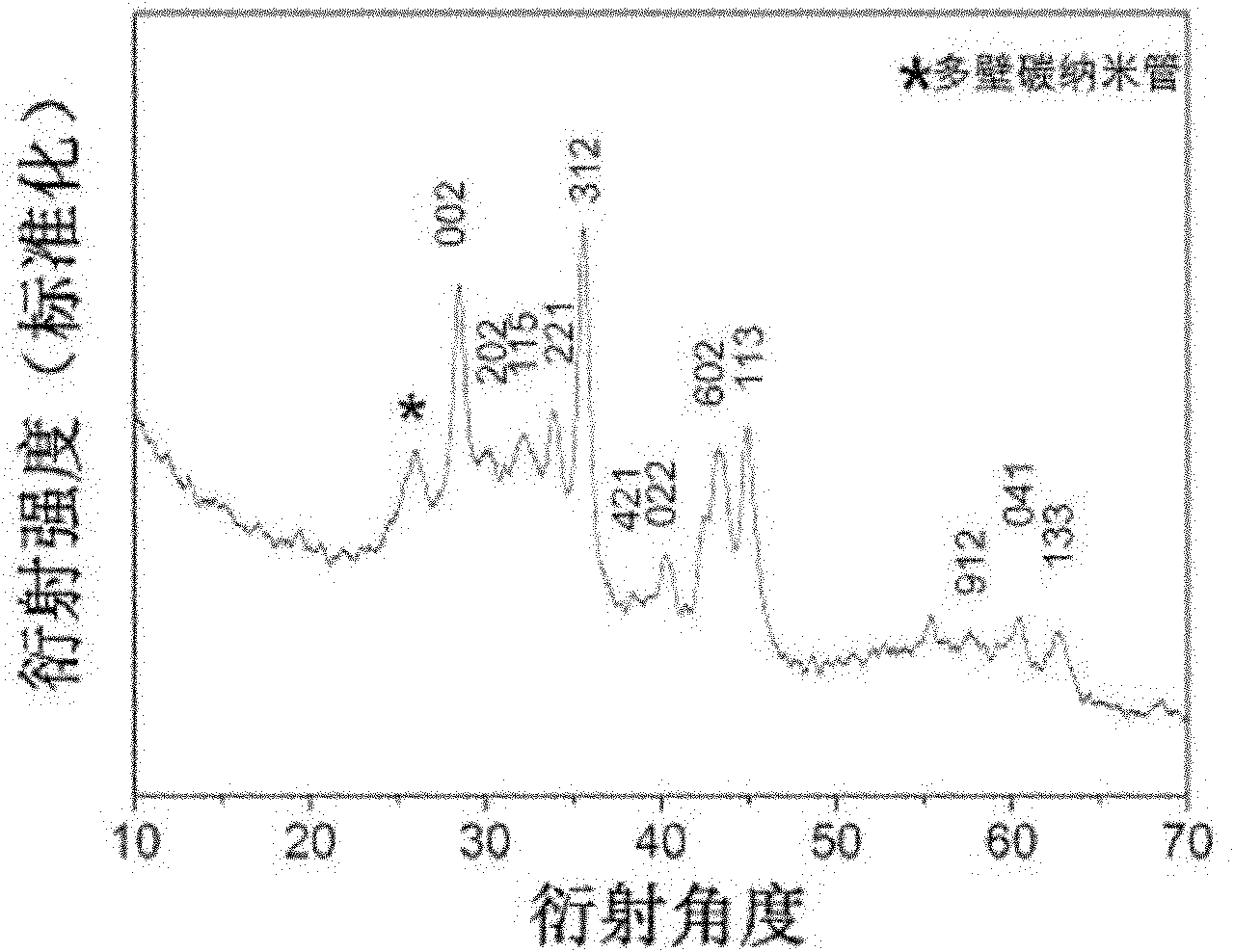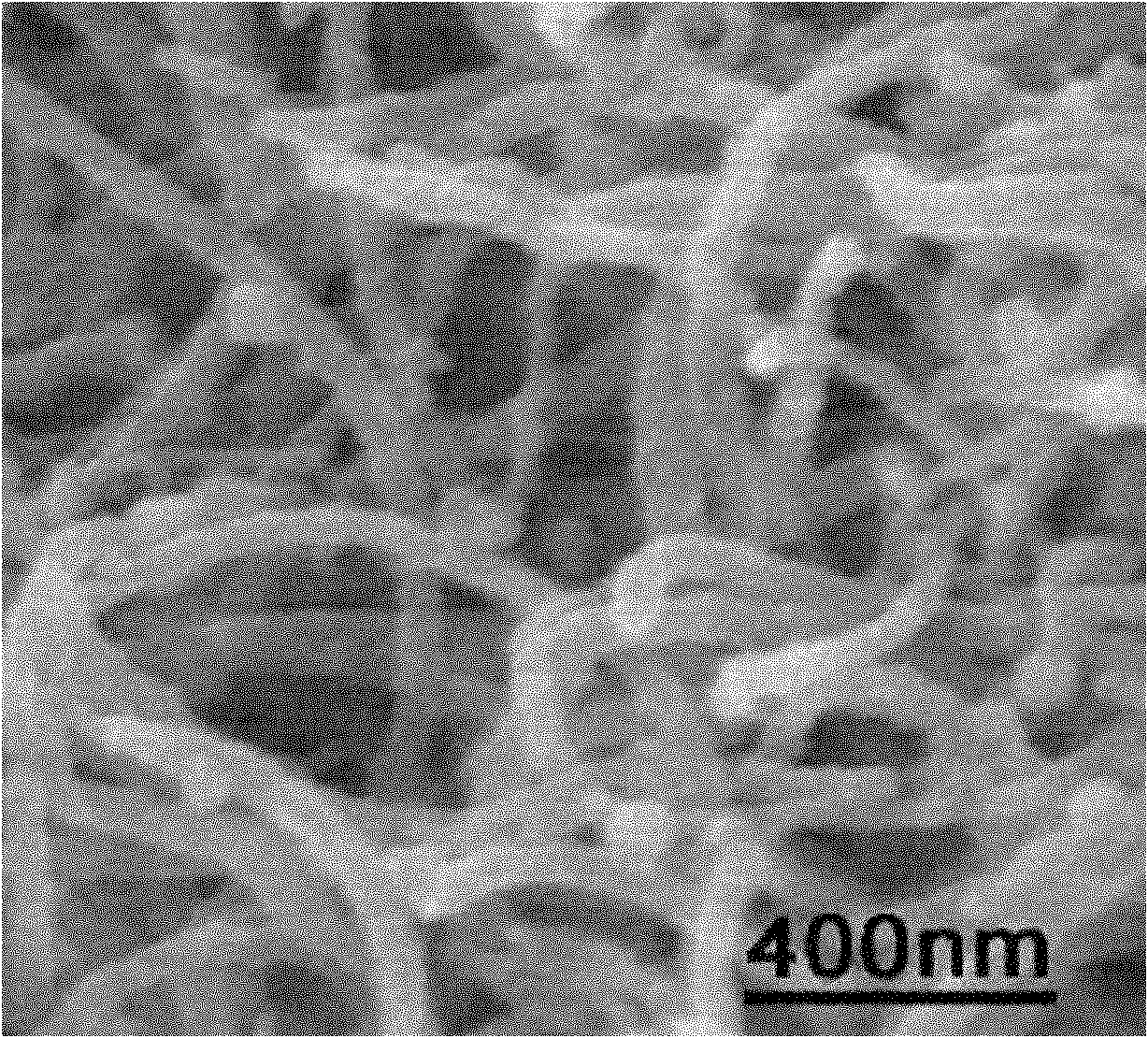Preparation method of composite material containing multi-walled carbon nanotubes and tin-cobalt alloy nanoparticles
A technology of multi-walled carbon nanotubes and nanoparticles, applied in the field of material science, to reduce agglomeration, the method is simple and easy, and the effect of reducing cycle stability
- Summary
- Abstract
- Description
- Claims
- Application Information
AI Technical Summary
Problems solved by technology
Method used
Image
Examples
Embodiment 1
[0025] (1) 60 milligrams of multi-walled carbon nanotubes are added to 50 milliliters of 0.5 mol / liter sodium chloride aqueous solution, and ultrasonic 1 hour, adding 20 grams of mass percent concentration is 2% polyallylamine hydrochloride aqueous solution (containing poly About 0.4 grams of allylamine hydrochloride, the number-average molecular weight of polyallylamine hydrochloride is 100000~200000), and stirred for 0.5 hour, then centrifuged with deionized water and then centrifuged to obtain modified multi-walled carbon nanotubes ;
[0026] (2) 10 millimoles of sodium borohydride are dissolved in 20 milliliters of diethylene glycol;
[0027] (3) 3 mmoles of tin chloride and 1 mmoles of cobalt chloride are dissolved in 10 milliliters of diethylene glycol;
[0028] (4) Add 60 mg of the modified multi-walled carbon nanotubes obtained in step (1) to the solution prepared in step (2), disperse them by ultrasonication for 10 minutes to obtain a mixed solution, and heat up unde...
Embodiment 2
[0034] (1) 60 milligrams of multi-walled carbon nanotubes are added to 50 milliliters of 0.5 mol / liter sodium chloride aqueous solution, and ultrasonic 1 hour, adding 20 grams of mass percent concentration is 2% polyallylamine hydrochloride aqueous solution (containing poly About 0.4 grams of allylamine hydrochloride, the number-average molecular weight of polyallylamine hydrochloride is 100000~200000), and stirred for 0.5 hour, then centrifuged with deionized water and then centrifuged to obtain modified multi-walled carbon nanotubes ;
[0035] (2) 10 millimoles of sodium borohydride are dissolved in 20 milliliters of diethylene glycol;
[0036] (3) 1.5 mmol tin chloride and 0.5 mmol cobalt chloride are dissolved in 10 milliliters of diethylene glycol;
[0037](4) Add 60 mg of the modified multi-walled carbon nanotubes obtained in step (1) to the solution prepared in step (2), disperse them by ultrasonication for 10 minutes to obtain a mixed solution, and heat up under the p...
Embodiment 3
[0041] (1) 60 milligrams of multi-walled carbon nanotubes are added to 50 milliliters of 0.5 mol / liter sodium chloride aqueous solution, and ultrasonic 1 hour, adding 20 grams of mass percent concentration is 2% polyallylamine hydrochloride aqueous solution (containing poly About 0.4 grams of allylamine hydrochloride, the number-average molecular weight of polyallylamine hydrochloride is 100000~200000), and stirred for 0.5 hour, then centrifuged with deionized water and then centrifuged to obtain modified multi-walled carbon nanotubes ;
[0042] (2) 5 millimoles of sodium borohydride are dissolved in 10 milliliters of diethylene glycol;
[0043] (3) 0.6 mmol tin chloride and 0.2 mmol cobalt chloride are dissolved in 5 milliliters of diethylene glycol;
[0044] (4) Add 60 mg of the modified multi-walled carbon nanotubes obtained in step (1) to the solution prepared in step (2), disperse them by ultrasonication for 10 minutes to obtain a mixed solution, and heat up under the pr...
PUM
| Property | Measurement | Unit |
|---|---|---|
| diameter | aaaaa | aaaaa |
Abstract
Description
Claims
Application Information
 Login to View More
Login to View More - R&D
- Intellectual Property
- Life Sciences
- Materials
- Tech Scout
- Unparalleled Data Quality
- Higher Quality Content
- 60% Fewer Hallucinations
Browse by: Latest US Patents, China's latest patents, Technical Efficacy Thesaurus, Application Domain, Technology Topic, Popular Technical Reports.
© 2025 PatSnap. All rights reserved.Legal|Privacy policy|Modern Slavery Act Transparency Statement|Sitemap|About US| Contact US: help@patsnap.com



